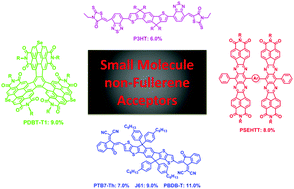Recent progress in non-fullerene small molecule acceptors in organic solar cells (OSCs)
Abstract
Power conversion efficiency (PCE) has surpassed 10% for single junction organic solar cells (OSCs) mainly through the design and synthesis of novel donor materials, the optimization of film morphology and the evolution of the devices. However, the development of novel acceptor materials is relatively sluggish compared with the donor compounds. Nowadays, fullerene derivatives, such as PC61BM and PC71BM, are still the dominant acceptors due to their superior charge transporting properties. Unfortunately, these two acceptors suffer from some intrinsic shortcomings such as limited absorption, difficult functionalization, and high production cost. Therefore, developing novel non-fullerene acceptors that can overcome the above-mentioned disadvantages is highly desirable. As a matter of fact, research on non-fullerene acceptors has made considerable progress in the last two years and a highest PCE of around 12% has been achieved. In this review, we will summarize recent research progress in non-fullerene small molecule acceptors and compare these molecules' performances in OSCs employing the same donor materials. Moreover, the acceptors with excellent photovoltaic performance are highlighted and the reasons are elaborated. Finally, the implications and the challenges are proposed.

- This article is part of the themed collection: Recent Review Articles


 Please wait while we load your content...
Please wait while we load your content...